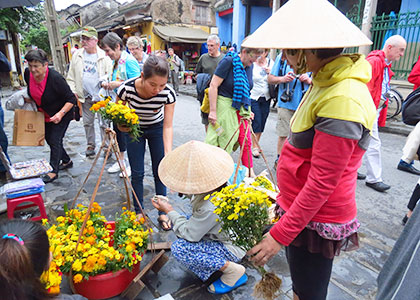Celebrating Tet in Vietnam
Tết or Tết Nguyên Đán or Vietnamese New Year is an important festival in the Vietnamese culture. The annual celebration marks the arrival of spring, based in the local Vietnamese Calendar. Usually, the festival falls during January or February. Tet in Vietnam is a celebration of new beginnings.
If you are interested to learn more about the Vietnamese culture, then do make it a point to visit the country during the month of Tet. The people celebrate the beginning of New Year with their families, and have a good time during the long public holidays.
Here you will learn some interesting details about this important festival in Vietnam, and understand how it is celebrated. In the end, you will find some valuable information on what you should do and not do during Tet in Vietnam.
So what are you waiting for? Let’s check how this important festival is celebrated in Vietnam.
What is Tet in Vietnam?
Tet, short for Tết Nguyên Đán, is an important holiday for Vietnamese people. The annual festival marks the beginning of the New Year according to the Vietnamese calendar. During the week-long public holiday, people celebrate the festival along with their families and enjoy a feast together.
The preparation for the festival begins close to two weeks early before the actual celebrations. Locals engage in annual cleaning and decoration of the house, buy new clothes, and pay off the debts – all to mark the new beginnings. During the feasts, extensive and elaborate meals are cooked and gifts are exchanged among families and friends. Overall, Tet in Vietnam is similar to Thanksgiving, Christmas, and New Year combined together.
How is Tet in Vietnam celebrated?

Chrysanthemums Sold During the Tet Festivities
|
Flowers and Tet
Flowers play an important role during the Tet festivities and are an integral part of the Tet decorations. Usually, the flowers are chosen depending on the location in Vietnam. However, the kumquat tree and chrysanthemums are very popular throughout the country. Makeshift flower markets erupt everywhere in the city, where huge crowd erupts to buy them.Food during Tet in Vietnam
The feast is an important part of every celebration, and it is no different for Tet. On the first day of the Tet, elaborate meals are organized for the families. The meals are cooked at home and display the vast culinary culture of Vietnam. The traditional Tet meals in Vietnam include:
It is probably the most important item in the Tet feast. The simple rice cake, stuffed with ground meat and mung beans, is a gluttonous affair. Wrapped in banana leaf, and tied with green ribbon – for good luck – the Banh sometimes looks like a white brick. According to local legends, an old emperor asked his sons to make a sumptuous meal. The winner of the cook-off would be the next ruler of the dynasty. Most sought after luxurious and exotic ingredients, but one. The prince made a humble rice cake that used local ingredients that were very tasty to eat. Needless to say, the prince became the next ruler and took the country to new heights.
Finger foods are an important component of the Tet feast. No meal is complete without it. Before the dinner begins, the guests are served with snacks and delicious ginger jam. Don’t get confused with the traditional western jams. Instead of a paste-like consistency, the ginger jam is essentially sugar-coated slices of ginger caramelized in a hot pan. The sweet and sour taste of the condiment tastes best with a piping cup of tea.
Another traditional item served in a welcome tray to the guests is the Mung bean cakes. Wrapped in a glossy paper, these beans taste great on their own.
The dried fruits are a healthy snack and are available in multiple varieties. Usually, fruits like lemons, peaches, tamarinds, jackfruits, mangoes, and pineapples are dried and dipped in the mixture of sugar, salt, and chili. At the end of the process, you get a candied fruit, which is a great snack.
Apart from these, the traditional Tet feasts consist of roasted melon seeds (Hạt dưa), fried spring rolls, and ground pork cooked with a variety of spices (Nem Chua).
Gifts during Tet in Vietnam
Gifts exchange is customary during the Tet celebrations. However, certain etiquettes are an important part of the gift exchange ceremony. These include:1. Paying off the debts before the beginning of the festivities.
2. Elders (people with income) give lucky money in red envelopes to children, it is supposed to bring good luck.
3. Fruit baskets, chocolates, cookies, wine are gifted among the families.
4. Wearing colorful dresses, whereas black and white clothes are usually avoided.
5. During the festive week, animal cruelty is usually avoided.
Lastly,
During Tet festivities, Vietnam is at its best. The cities are decorated in-season decorations and flowers, people exchange gifts and entire streets are left for the tourists to explore on their own. Also, if you are visiting Vietnam during Tet, do wish the locals Happy New Year. Or, better say ‘chúc mừng năm mới’ (pronounced chook moong Nahm Moi) – that’s Happy New Year in Vietnamese.
Interestingly, the busy streets of Vietnam suddenly become quiet during the Tet celebrations. The local shops close down for business. However, visitors like you should not worry. There are plenty of small cafes and western restaurants available during the holiday season.

